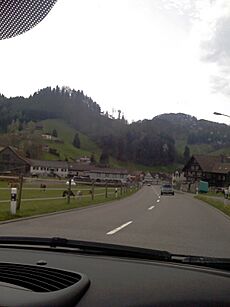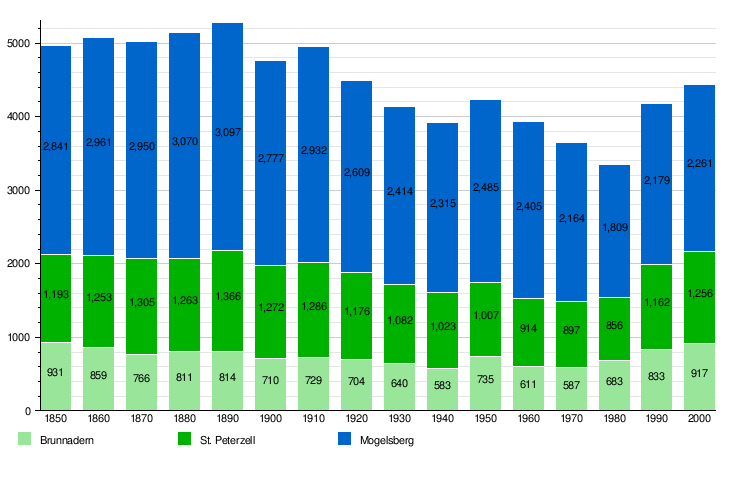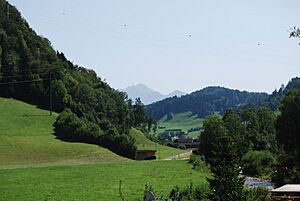Neckertal facts for kids
{{Infobox Swiss town | subject_name = Neckertal | image_photo = 2011-08-21-Wald Neckertal (Foto Dietrich Michael Weidmann) 282.JPG | municipality_type = municipality | imagepath_coa = CHE Neckertal COA.svg|pixel_coa= | imagepath_flag = CHE Neckertal Flag.svg | canton = St. Gallen | iso-code-region = CH-SG | district = Toggenburg |coordinates = 47°20′N 9°8′E / 47.333°N 9.133°E | postal_code = 9105 Wald/Schönengrund
9115 Dicken
9122 Mogelsberg
9123 Nassen
9125 Brunnadern
9126 Necker
9127 St. Peterzell
9621 Oberhelfenschwil
9633 Hemberg | municipality_code = 3378 | area = 49.03 | elevation = 660|elevation_description= | population = 4064 | populationof = December 2020 | website = www.neckertal.ch | mayor = |mayor_asof=|mayor_party= | mayor_title = |list_of_mayors = | places = Brunnadern, St. Peterzell, Mogelsberg, Wald-Schönengrund, Nassen, Hoffeld, Ebersol, Dicken, Dieselbach, Necker, Oberhelfenschwil, Hemberg | demonym = | neighboring_municipalities= Oberhelfenschwil, Wattwil, Hemberg, Degersheim, Ganterschwil, Lütisburg, Schwellbrunn (AR), Schönengrund (AR) | twintowns = |} Neckertal is a municipality located in the Toggenburg district of the Canton of St. Gallen, Switzerland. It's like a small town or area with its own local government.
This municipality was created on January 1, 2009. It was formed by joining three smaller places: Brunnadern, St. Peterzell, and Mogelsberg. Later, on January 1, 2023, two more municipalities, Hemberg and Oberhelfenschwil, also joined Neckertal. This made Neckertal even bigger!
Contents
Exploring Neckertal's Geography

Neckertal covers an area of about 49 square kilometers (or 18.9 square miles). Imagine a big piece of land! A large part of this land, about 53.4%, is used for farming. This means there are many fields and pastures.
Almost 40% of Neckertal is covered by forests, which are great for exploring nature. About 5.7% of the land has buildings and roads. The rest is made up of rivers, lakes, and some land that isn't used for anything.
The municipality includes several villages. The main ones are Brunnadern, St. Peterzell, and Mogelsberg. There are also smaller hamlets like Wald-Schönengrund, Dicken, and Necker.
Understanding Neckertal's Population
Neckertal has a population of about 4,200 people. This number can change a little each year. In 2012, about 7.9% of the people living there were from other countries.
Most people in Neckertal speak German. About 95.5% of the population uses German as their main language. A small number of people speak Italian or French.
In 2012, young people (ages 0-19) made up about 23.8% of the population. Adults (ages 20-64) were the largest group, at 60.8%. Seniors (over 64 years old) made up about 15.3% of the population.
There are many different types of homes in Neckertal. In 2010, there were 460 homes where only one person lived. There were also 206 homes with five or more people. Most of the homes in the municipality are single-family houses.
How Neckertal's Population Changed Over Time
The chart below shows how the number of people living in Brunnadern, St. Peterzell, and Mogelsberg changed over many years. This helps us see how the population grew or shrunk before these places joined to form Neckertal.

Neckertal's Economy and Jobs
In 2011, Neckertal had a very low unemployment rate, only 1.51%. This means most people who wanted a job had one. There were 1,531 people working in the municipality.
Jobs are divided into three main types:
- Primary sector: These jobs involve getting raw materials from nature. In Neckertal, this means farming. About 374 people worked in farming, with 168 businesses.
- Secondary sector: These jobs involve making things in factories or workshops. About 404 people worked in this area, with 76 businesses.
- Tertiary sector: These jobs involve providing services to people. This includes things like shops, schools, and hospitals. About 753 people worked in services, with 190 businesses.
Many people in Neckertal use private cars to get to work (46.1%). A smaller number, 14.5%, use public transportation like buses or trains.
Important Historic Buildings in Neckertal
Neckertal is home to some very old and important buildings. Three buildings in Mogelsberg are considered "heritage sites of national significance." This means they are very special and protected.
These buildings are:
- the Haus Näf
- the Oberes Türmlihaus
- the Unteres Türmlihaus
The whole village of Mogelsberg and the Spreitenbach / Furth area are also recognized as important Swiss heritage sites. They are like living museums!
Religion in Neckertal
In 2000, most people in Neckertal belonged to a Protestant church (about 53.9%). About 31.2% were Roman Catholic. A smaller group, 7.5%, did not have a religious affiliation.
Education Opportunities in Neckertal
Education is important in Neckertal. About 51.4% of the people have finished their non-mandatory upper secondary education. This is like finishing high school.
Also, 14.5% of the population has gone on to higher education. This means they have studied at a university or a Fachhochschule (a type of professional university).
See also
 In Spanish: Neckertal para niños
In Spanish: Neckertal para niños






